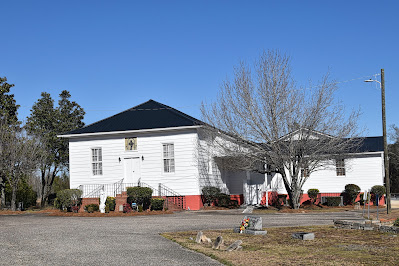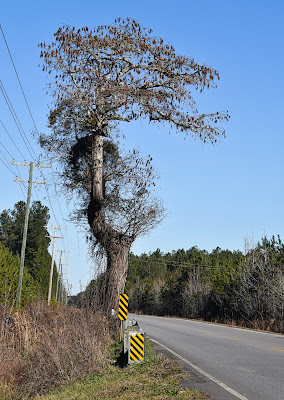These posts are generally confined to Kingstree and its history. However, I recently ran across this interesting article on Andrews. Written by Martha W. Millard, this story was published in the News & Courier on September 4, 1939, as part of what would become the paper's long-running "Do You Know Your South Carolina?" feature. Edwin Harper, who had lived much of his life in Kingstree, also played an important role in the early days of Andrews, as did Col. Philip F. Wiehrs, father of Paul Wiehrs. Paul lived for many years in Kingstree, as well. Here is Mrs. Millard's article:
"Andrews, situated at the intersection of highways 511 and 521 on the Seaboard Air Line railway, was incorporated in 1909. The surrounding community is rich in history and tradition.
"Prior to 1886, the community center was located at Harper's Crossroads about a mile northeast of the present site of Andrews. In 1886, the Georgetown and Western Railroad, operating between Georgetown and Lane, opened regular service. The original Harper's station was where West Andrews is now, and several business establishments soon were opened, the first by Edwin Harper, followed by L.J. Hutson, Daniel Bruorton, W.S. Camlin, and L.A. Rogerson. The post office was in Harper's store with Edwin Harper as the first postmaster.
"In September 1909, through the work of Walter H. Andrews and his associates, the town of Rosemary was incorporated separately from Harper's. Gill G. Davis was the first mayor. The tract, two miles long and one mile wide, was bought from Edwin Harper, and a map was made of the town as it was planned by these men, which still is used today. The name Rosemary was adopted at the suggestion of Mr. Andrews, who was a lover of the Rosemary pine, indigenous to this section of the country. Two years later, the two towns voted to join, both names were discarded, and the names Andrews and West Andrews were adopted. The post office was moved to Andrews with Tom Blakeley as postmaster.
"Serving as mayor during the last 30 years have been J.L. Grant, C.J. Levy, Dr. D.S. Porter, W.H. Andrews, Dr. J.H. Porter, and the present mayor, C.T. Bell, who has served since 1931.
"The rapid growth of the town was due in some measure to Seaboard shops and the machine shops of the Atlantic Coast Lumber Corporation. In less than 20 years the population has reached 2,000 people. The moving of the Seaboard shops in 1929 and the closing of the mill in 1932 caused a decrease in population to approximately 1,600. The last census, however, gave a population of 1,763, showing some growth.
"The outstanding occupations of the section are farming and the handling of forest products. There are great possibilities for the future as the location is on the dividing line of the coastal plain and lower pine belt, where soil is fertile and particularly well adapted to the growth of agricultural products.
"Among those who have helped to make history for Andrews are Edwin Harper, from whom the land was bought for the site of the town; his son, S. Paul Harper, who put on a resettlement campaign; the late Walter H. Andrews, founder of the town and a leader in political affairs of the country, and Colonel Philip F. Wiehrs, who at the time of his death was commanding officer of the 178th Field Artillery, South Carolina National Guard. Dr. John H. Porter, a native of the county has been a practicing physician in Andrews for 16 years, serving as mayor for two years and a the present time serving his fifth consecutive term in the Legislature as representative from Georgetown County.
"One of the interesting historical spots near Andrews is the chapel of ease to Prince George, Winyah. It is said to be the first Episcopal chapel erected in the United States. This chapel is on highway 511, five miles from town.
"Highway 511 was at one time a stage road. It was used first by the Huguenots who migrated from Charleston, crossing the Santee River at Murray's Ferry, which crossing was later moved to Lenud's, and crossing Black River at Potato Ferry. The road was used during the Revolution by Francis Marion and his swamp foxes.
"Another spot of interest is "Hangman's Tree," about 10 miles from Andrews on the Anderson Road leading from Georgetown to Lenud's Ferry. This tree is said to have been used for hangings during Reconstruction days."
P.S.: Boatloads of appreciation to Rod McCants and Wendell Voiselle who helped me pull this one together.






7 comments:
I presume that this is the same Edwin Harper buried in Wmbg. Presbyterian Cemetery. He was a CSA veteran (Co H, 7th SC Cav).
Yes, this is the same Edwin Harper.
Mary Ruth Harper Ragland
Edwin Harper was my great grandfather. He was the father of Paul Harper, married to Clara Montgomery. Paul and Clara lived in Andrews. They were my father's parents, Robert Davidson Harper, M.D. Granddaddy Paul was a surveyor and was connected with International Paper Co. Daddy was in the Navy during WWII and practiced medicine in Andrews for 50 years. Dr. Porter had retired when Daddy started his practice. Dr. Whitley had a family medical practice in Andrews also.
Edwin Harper was my great grandfather. Paul Harper, my grandfather was married to Clara Montgomery. Granddaddy was a surveyor and connected to International Paper Co. Robert Davidson Harper, M.D. was my father. He was in the Navy during WWII. Dr. Porter had retired when my father began his medical practice in Andrews. Dr. Whitley was still practicing when Daddy returned to Andrews.
Such rich history. I grew up at Six Mile Crossing off US 521.
Oh my so many memories of my childhood. I remember, Dr. Harper, Dr Porter and Dr. Whitley. My brother worked for Dr. Whitley in his drug store. Loved reading names that has been a big part of my life.
So many memories of my childhood. Love the History. Thanks for sharing
Post a Comment